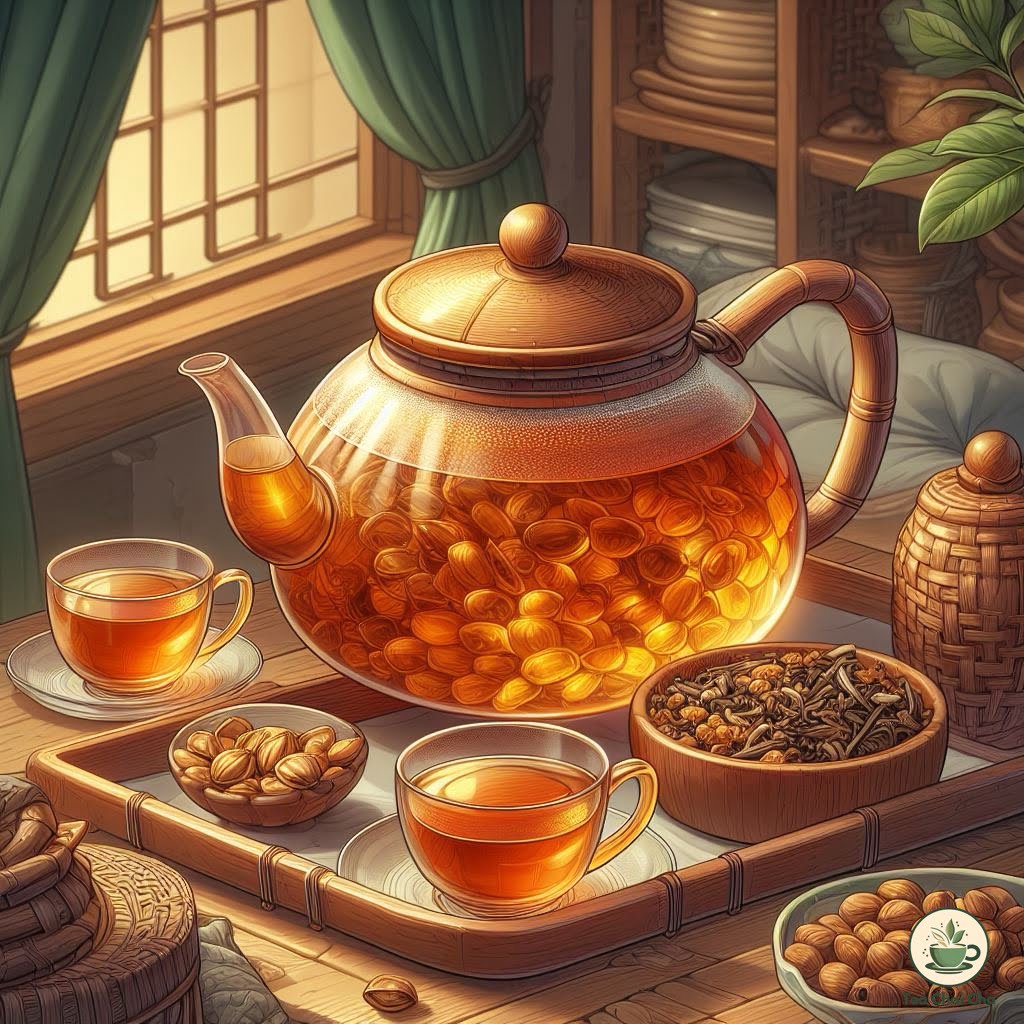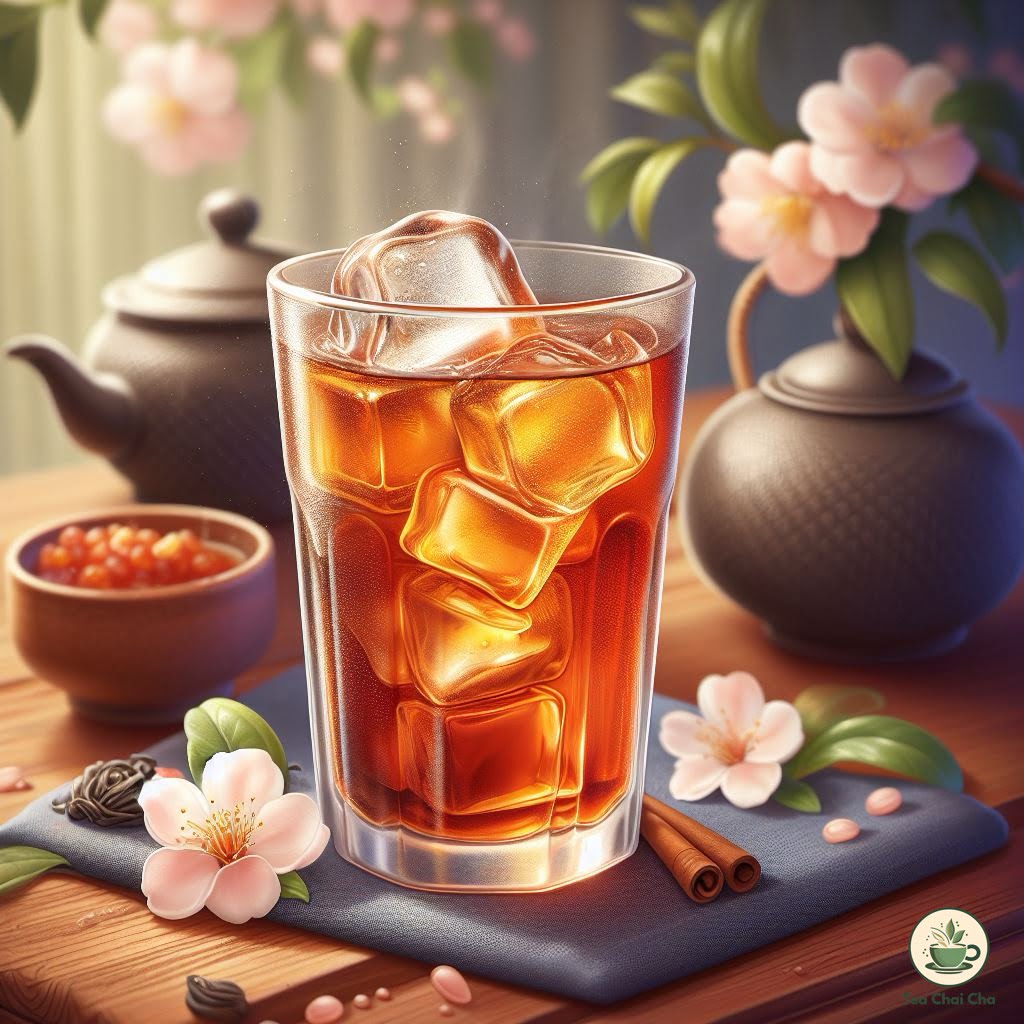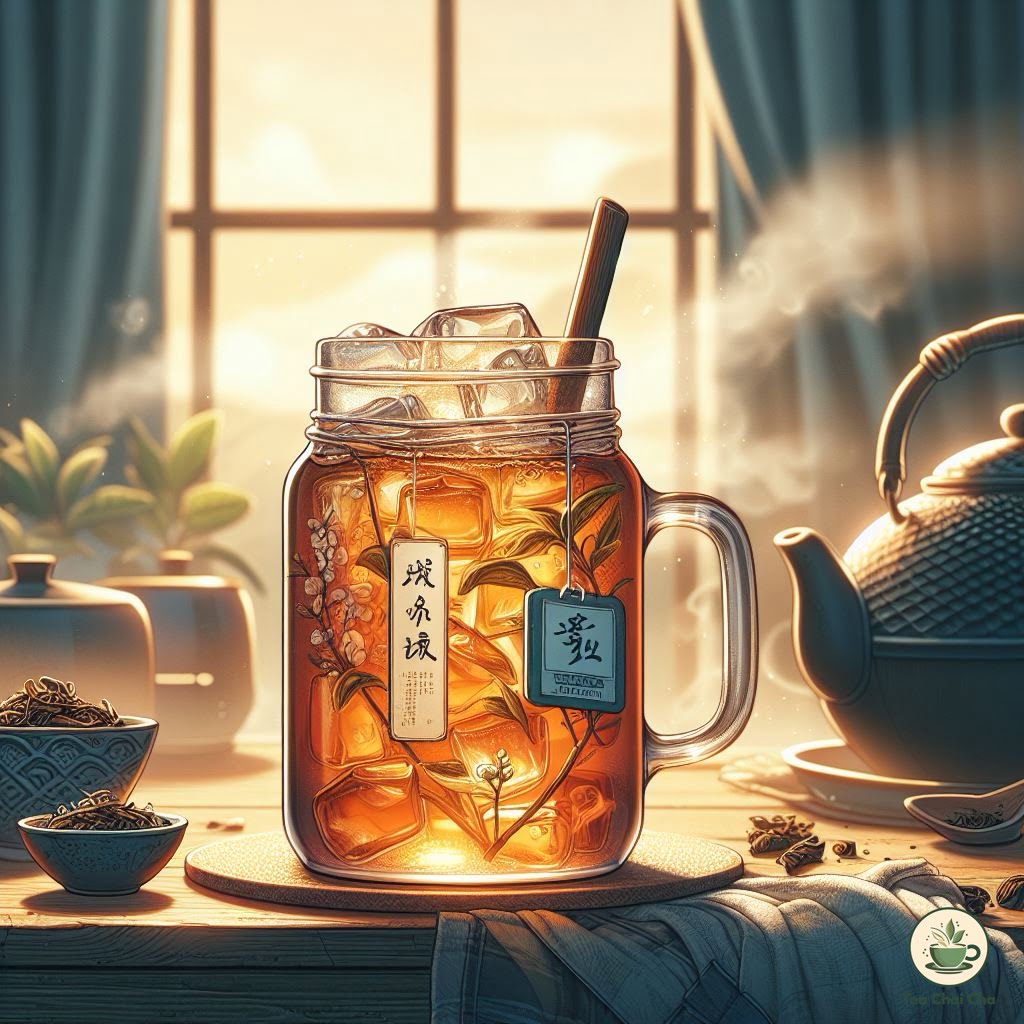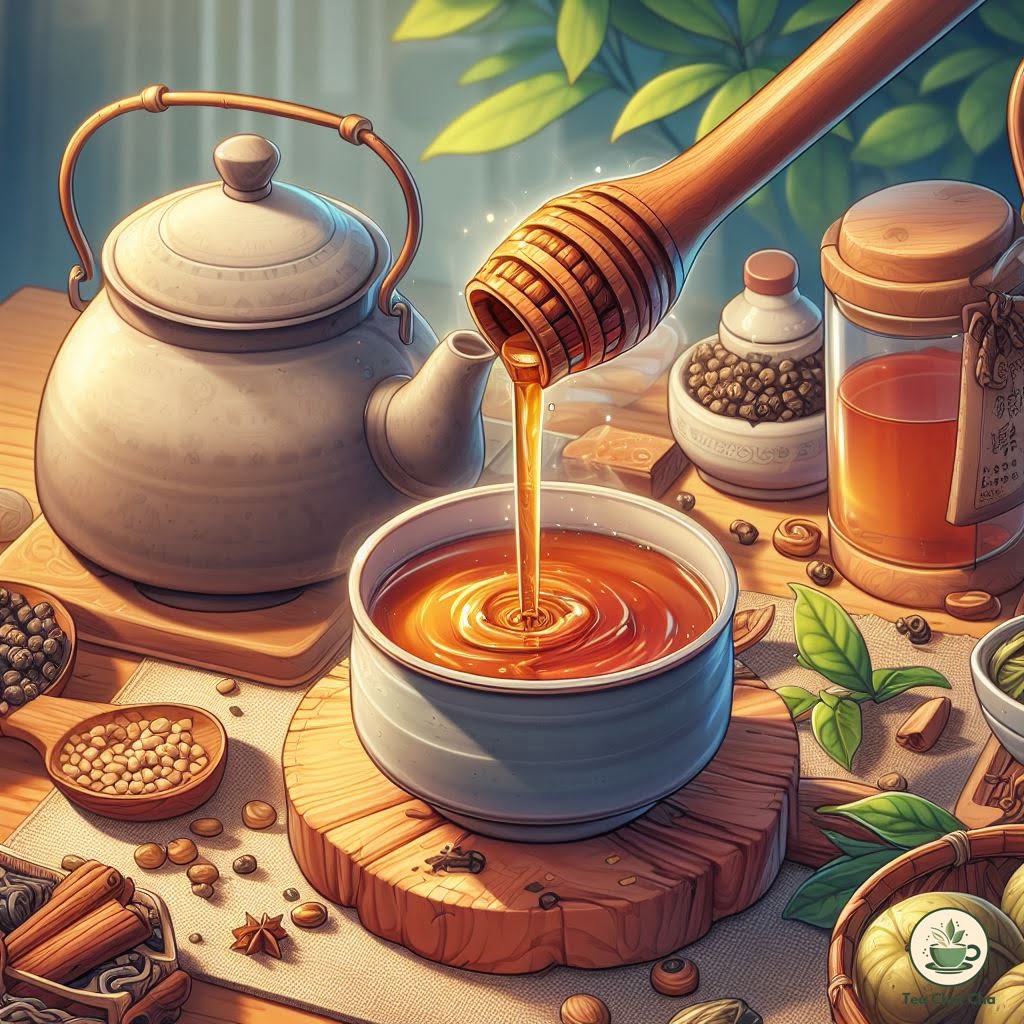Are you tired of the same old tea routine, searching for a flavor that truly awakens your senses? I hear you.
Oolong tea, known for its diverse flavor spectrum, can sometimes feel like a tantalizing glimpse of something extraordinary, just out of reach.
But fear not, because I’m about to introduce you to Tie Luo Han, the answer to your tea woes.
Originating from the awe-inspiring Wuyi Mountains in China, Tie Luo Han, or “Iron Arhat” tea, is a speciall cup of tea.
It’s a tea that carries the very essence of those ancient rocky landscapes, delivering a mix of floral, nutty, and mineral notes that will redefine your tea experience.
So, if you’ve ever found yourself yearning for a tea that truly satisfies your taste buds, stay with me.
If you are here for the quick recipe, scroll to the bottom and brew your Tie Luo Han in minutes!

What Is Tie Luo Han Wuyi Oolong Tea?
Tie Luo Han Wuyi Oolong Yan Cha is a remarkable oolong variety.
It comes from the Wuyi Mountains in China, a place renowned for its exceptional tea.
These mountains are in Fujian Province, and they’re known for their rocky terrain, which imparts unique qualities to the tea.
Tie Luo Han is considered a dark oolong tea due to its oxidized leaves.
The tea bushes grow in this rocky environment, absorbing the minerals from the soil (that’s why it’s called Yancha/rocky tea.)
This distinct setting contributes to the tea’s special character.
China has a rich tradition of oolong tea, and Tie Luo Han is a proud part of that heritage.
It’s known for its complex flavor, which combines floral and fruity notes with roasted undertones, making it a unique and captivating tea.
Iron Monk/ Iron Arhat Rock Oolong
Tie Luo Han, often called “Iron Monk/ Iron Warrior Monk” or “Iron Arhat Rock Oolong,” boasts names that reflect its character.
“Iron” suggests its strength and robustness, while “Arhat” conveys an aura of wisdom and enlightenment.
These names are fitting for a tea known for its bold flavor and deep complexities.
Tie Luo Han is also one of the “Four Great Wuyi Rock Teas,” a prestigious group of oolong teas originating from the Wuyi Mountains.
This group includes Da Hong Pao, Shui Jin Gui, and Bai Ji Guan.
These teas are celebrated for their unique tastes, each with its own distinct personality and charm.
Legends and History of Tie Luo Han
The original Tie Luo Han mother bush was found near Nei Gui Cave in the mountains.
They called it “Iron Monk” to honor the monks who protected the temple and practiced kung fu daily.
After their exercises, they’d pick tea leaves near the cave and savor its unique flavor.
This tea’s roots trace back to the Song Dynasty (960-1279), known for its excellent taste and sturdy branches.
Tie Luo Han bushes look like willow trees with glossy leaves and pronounced veins.
They made their mark in green tea making during the Song Dynasty and gained prominence as the first of the “Four Famous Rock Wulongs” in the 17th century, as documented by Guo Bo Cang in 1886.

How to Make Tie Luo Han Tea
Now that you know where your Tie Luo Han tea comes from and its legends, lets try and make the best tasting smoky oolong you have ever savored.
For one serving of Tie Luo Han Tea, you’ll need the following ingredients and equipment:
Ingredients For Tie Luo Han
- 2 grams of Tie Luo Han tea leaves (about one teaspoon)
- 200 milliliters of freshly boiled water (approximately 7 ounces)
Equipment
- A teapot or a gaiwan (a Chinese lidded bowl used for brewing tea)
- A tea strainer (optional)
- A tea cup or mug
Now, let’s get to brewing:
Step 1: Boil Water
Start by boiling your water.
Tie Luo Han tea is best brewed at 212°F (100°C), so make sure your water reaches a rolling boil.
Step 2: Measure Tea Leaves
While the water is boiling, measure out 2 grams of Tie Luo Han tea leaves.
You can adjust the quantity to your taste, but this is a good starting point for one serving.
Step 3: Heat Water
Once the water has reached the boiling point, let it sit for a moment to cool slightly.
This helps prevent scalding the delicate tea leaves.
Step 4: Warm Teapot/Gaiwan
Rinse your teapot or gaiwan with a small amount of hot water.
This helps to warm up the vessel and enhance the tea’s flavor.
Step 5: Add Tea Leaves
Add the tea leaves to your teapot or gaiwan.
Step 6: Initial Steeping
Pour the hot water over the tea leaves.
Use about 200 milliliters (or 7 ounces) of water for this step.
Let the tea steep for about 3-10 seconds for the first infusion.
Remember, Tie Luo Han tea can be steeped multiple times, so these initial seconds are just the beginning.
If you want to reduce the caffeine in Tie Luo Han, you can discard the first infusion as it contains 80% of the tea’s caffeine.
Besides, it’s good to give your tea a gentle “wash” or “rinse” to get rid of toxins.
Step 7: Strain and Serve
After the initial steeping, pour the tea into your tea cup or mug.
You can use a tea strainer if you prefer a clearer tea, but it’s optional.
Step 8: Sip and Enjoy
Take in the rich, complex flavors of your Tie Luo Han tea.
You can enjoy 6-8 infusions, gradually increasing the steeping time by 5 seconds for each subsequent brew.
Scroll to the bottom to have complete recipe with ingredients and instructions.

Tie Luo Han Tea Hot or Cold?
Tie Luo Han tea is a versatile brew.
Some people like it hot, while others prefer it cold.
It’s all about personal taste and the weather.
For me, enjoying Tie Luo Han hot feels like a warm hug on a chilly day.
The flavors are rich and comforting.
On the flip side, when it’s scorching outside, I turn to iced Tie Luo Han.
It’s like a cool breeze in a glass, refreshing and revitalizing.
Just brew it your way and savor every sip.

How to Make Iced Tie Luo Han Tea – Cold Brew Tie Luo Han
Making iced Tie Luo Han tea is a breeze, and it’s a great way to enjoy this tea on a hot day.
Here’s how I like to do it:
Ingredients for Cold Brew Tie Luo Han
- 2 grams of Tie Luo Han tea leaves (around one teaspoon)
- 200 milliliters of cold, filtered water (about 7 ounces)
Equipment
- A pitcher or a French press
Step 1: Start by measuring out 2 grams of Tie Luo Han tea leaves.
You can adjust the quantity to your taste, but this is a good starting point for one serving.
Step 2: Place the tea leaves in a pitcher or French press.
Step 3: Pour in 200 milliliters (7 ounces) of cold, filtered water over the tea leaves.
Step 4: Stir gently to make sure the tea leaves are fully immersed in the water.
Step 5: Put the lid on the pitcher or French press and place it in the refrigerator.
Step 6: Let it steep in the refrigerator for at least 4 hours, or even overnight for a richer flavor.
Step 7: When it’s ready, simply pour the cold-brewed Tie Luo Han tea into a glass with ice.
You can add a touch of honey or a slice of lemon if you like.
Step 8: Sip and enjoy the refreshing, cold, and subtly complex flavors of your Iced Tie Luo Han Tea.
It’s a perfect way to stay cool and invigorate your taste buds on a warm day.
10 Factors That Affect the Flavor of Tie Luo Han Tea
Understanding the nuanced flavors of Tie Luo Han tea requires a closer look at the factors that shape its taste.
Just as a fine wine reflects its terroir and a chef’s touch, this exceptional oolong is influenced by various elements.
1. Terroir and Origin
Where Tie Luo Han tea is grown plays a pivotal role in its flavor.
The mineral-rich soil and unique microclimates of the Wuyi Mountains contribute distinct characteristics to the tea leaves.
2. Tea Bush Cultivar
Different cultivars of the tea plant can yield varying flavor profiles.
Tie Luo Han comes from specific cultivars that have been carefully nurtured for their unique qualities.
3. Oxidation Level
Tie Luo Han is classified as a dark oolong due to its level of oxidation.
The degree of oxidation affects the flavor, with darker oolongs having deeper, roasted notes.
4. Roasting Technique
The roasting process plays a significant role in shaping the flavor.
It can enhance the tea’s depth and bring out toasty, nutty notes.
5. Harvesting Time
The timing of the tea leaf harvest matters.
Leaves picked in the spring tend to have a more delicate and floral flavor, while those harvested later in the year may be more robust.
6. Brewing Method
How you brew Tie Luo Han tea impacts its taste.
Adjusting factors like water temperature and steeping time allows you to highlight specific flavor notes.
7. Storage
Proper storage is crucial to maintain the tea’s quality.
Storing it away from strong odors and in an airtight container helps preserve its flavor.
8. Aging
Some tea enthusiasts believe that aging Tie Luo Han tea can enhance its flavor, just like fine wine or cheese.
The aging process can lead to smoother, more mellow notes.
9. Water Quality
The quality and mineral content of the water used for brewing can influence the tea’s taste.
Pure, filtered water is often recommended to avoid interfering with the tea’s natural flavors.
10. Personal Preference
Lastly, individual taste is a significant factor. What one person finds delightful, another may not.
Exploring Tie Luo Han tea and adjusting brewing methods to your liking is all part of the journey.

How to Make Tie Luo Han Tea Taste Good
To elevate the taste of your Tie Luo Han tea and explore its full spectrum of flavors, consider these tips and add-ons:
1. Start with Quality Tea Leaves
The foundation of great-tasting Tie Luo Han tea lies in using high-quality tea leaves.
Look for reputable sources and ensure your tea is fresh.
2. Measure with Precision
For a single serving, use about 2-6 grams of tea leaves (around one to three teaspoon).
Adjust the quantity to your taste.
3. Optimal Water Temperature
When brewing hot Tie Luo Han tea, fresh water at a rolling boil (212°F or 100°C) works best.
For cold brew, use cold water and steep in the refrigerator for several hours.
4. Hot Brew Magic
- Short and Sweet: Keep the initial steeping short, around 3-10 seconds. This allows you to capture the essence without overwhelming the flavors.
- Subsequent Infusions: Extend the steeping time by 5 seconds with each brew. This progressive approach lets you explore the tea’s depth.
5. Cold Brew Coolness
- Cold Water Patience: Place the tea leaves in cold water and let them steep in the fridge for 4-12 hours.
- Ice and Garnish: Serve with ice cubes and consider adding a slice of lemon or sprig of mint for a refreshing twist.
6. Experiment with Flavor
To tailor the taste to your liking, consider:
- Honey or Sweetener: A touch of honey or sugar can accentuate the tea’s natural sweetness.
- Citrus Zest: Lemon or orange zest adds a zingy note.
- Fruit Infusions: Experiment with slices of fruit like peach or berries for a fruity infusion.
- Mint Leaves: A few fresh mint leaves can impart a refreshing flavor.

Tie Luo Han Tea Food Pairing
When it comes to enjoying Tie Luo Han tea with food, there are some fantastic pairings to explore.
Here are some ideas:
Savory Pairings
-> Roasted Meats: Think of pairing Tie Luo Han with dishes like Peking duck or roasted pork.
The tea’s earthy and nutty notes beautifully complement the richness of these meats.
-> Sushi and Seafood: If you’re a fan of sushi or seafood, you’ll appreciate how Tie Luo Han’s floral and mineral hints enhance the flavors of these dishes.
-> Spicy Dishes: For those who enjoy a bit of spice, Tie Luo Han can handle the heat.
It’s a great match for spicy cuisines like Sichuan or Thai dishes.
-> Cheese: Try enjoying Tie Luo Han with mild cheeses like brie or Camembert.
The tea’s subtleties create an interesting contrast with the creaminess of the cheese.
Sweet Pairings
-> Dark Chocolate: Bite on dark chocolate alongside Tie Luo Han.
The tea’s roasted hints blend wonderfully with the depth of dark chocolate.
-> Nuts: Whether you have almonds, pecans, or hazelnuts, they all pair excellently with Tie Luo Han.
The tea’s nutty character complements the flavors of the nuts.
-> Fruit Desserts: After a meal, consider having Tie Luo Han with fruit-based desserts like apple pie.
The tea’s fruity undertones can accentuate the sweetness of the dessert.
Chinese Tradition
In Chinese tradition, Tie Luo Han tea is often enjoyed with dim sum.
The tea’s versatility makes it a great companion for the variety of dishes served during dim sum.
During the Mid-Autumn Festival, Tie Luo Han tea is a common companion to mooncakes.
The tea’s floral and roasted notes harmonize beautifully with the sweet and savory mooncake flavors.

When to Drink Tie Luo Han Tea
I find that it’s best enjoyed in the morning.
Tie Luo Han gives you that gentle caffeine boost (with 17-55 mg caffeine per cup) to kickstart your day without those pesky jitters.
The rich and earthy flavors keep you focused and energized.
But in the evening, I recommend going for caffeine-free teas to relax and ensure a good night’s sleep.
Related Oolong Tea Guides

Tie Luo Han/ Iron Monk Tea Recipe
Recipe by Tania FaysalCourse: DrinksCuisine: Chinese4
servings1
minute4
minutes2
kcal5
minutesImmerse yourself in the traditional Chinese tea ceremony with this Tie Luo Han tea recipe - a soulful experience for 4 tea lovers.
Ingredients
8 grams of Tie Luo Han tea leaves
1 liter of purified water
Directions
- Prepare the Tea Leaves: Begin by measuring out 8 grams of Tie Luo Han tea leaves. Place them in a Yixing clay pot or a Gaiwan.
- Heat the Water: In a kettle, bring 1 liter of purified water to a gentle boil. The ideal steeping temperature for this tea is 205-212°F (96-100°C).
- Rinse the Leaves: Pour a little of the heated water over the tea leaves to rinse them. This helps awaken their flavor. Discard the rinse water.
- Steep the Tea: Pour the remaining water over the tea leaves, cover the pot, and let it steep for around 30 seconds for the first infusion. Increase steeping time by 5 seconds for each subsequent infusion. You can steep the tea for 6 to 8 times.
- Serve and Enjoy: Pour the brewed tea into tea cups or tasting cups and savor the complex flavors of this traditional Oolong tea.
Recipe Video
Notes
- Storing Brewed Tea: Once you've brewed your Tie Luo Han tea, it's best to enjoy it right away. If you can't finish it all, store it in an airtight container to maintain its freshness. Avoid leaving it out for too long as it can lose its flavor.
- Gongfu Style: To truly savor the intricate flavors of Tie Luo Han, consider using the Gongfu style of brewing. This method involves multiple short steepings in a small teapot or gaiwan. It allows you to appreciate the tea's evolving taste with each infusion, bringing out its full range of flavors.
- Steeping Multiple Times: Oolong tea is known for its ability to be steeped multiple times, usually 6-8 times. Start with a short initial infusion and gradually increase the steeping time with each subsequent brew.
- Cold Brew with Fruits: If you're looking for a refreshing twist, try turning Tie Luo Han into a cold brew. Simply place your tea leaves in cold water and let them steep in the fridge for a few hours or overnight. You can also add slices of fruits like citrus or berries for a tasty infusion of flavors.
Frequently Asked Questions (FAQs)
What does Tie Luo Han tea taste like?
Tie Luo Han tea has a unique taste profile that’s often described as smoky, rich, earthy, and slightly floral with a hint of sweetness.
Does Tie Luo Han tea have caffeine?
Yes, Tie Luo Han tea does contain caffeine, typically ranging from 17-55 mg per cup, which can provide a gentle energy boost.
Is Tie Luo Han a real tea?
Tie Luo Han is indeed a real type of tea. It comes from the Camellia sinensis plant known for its long history and unique flavor characteristics.
How many calories are in Tie Luo Han tea?
Tie Luo Han tea is very low in calories, typically containing only about 2 calories per 8-ounce cup when consumed without added sugar or milk.
